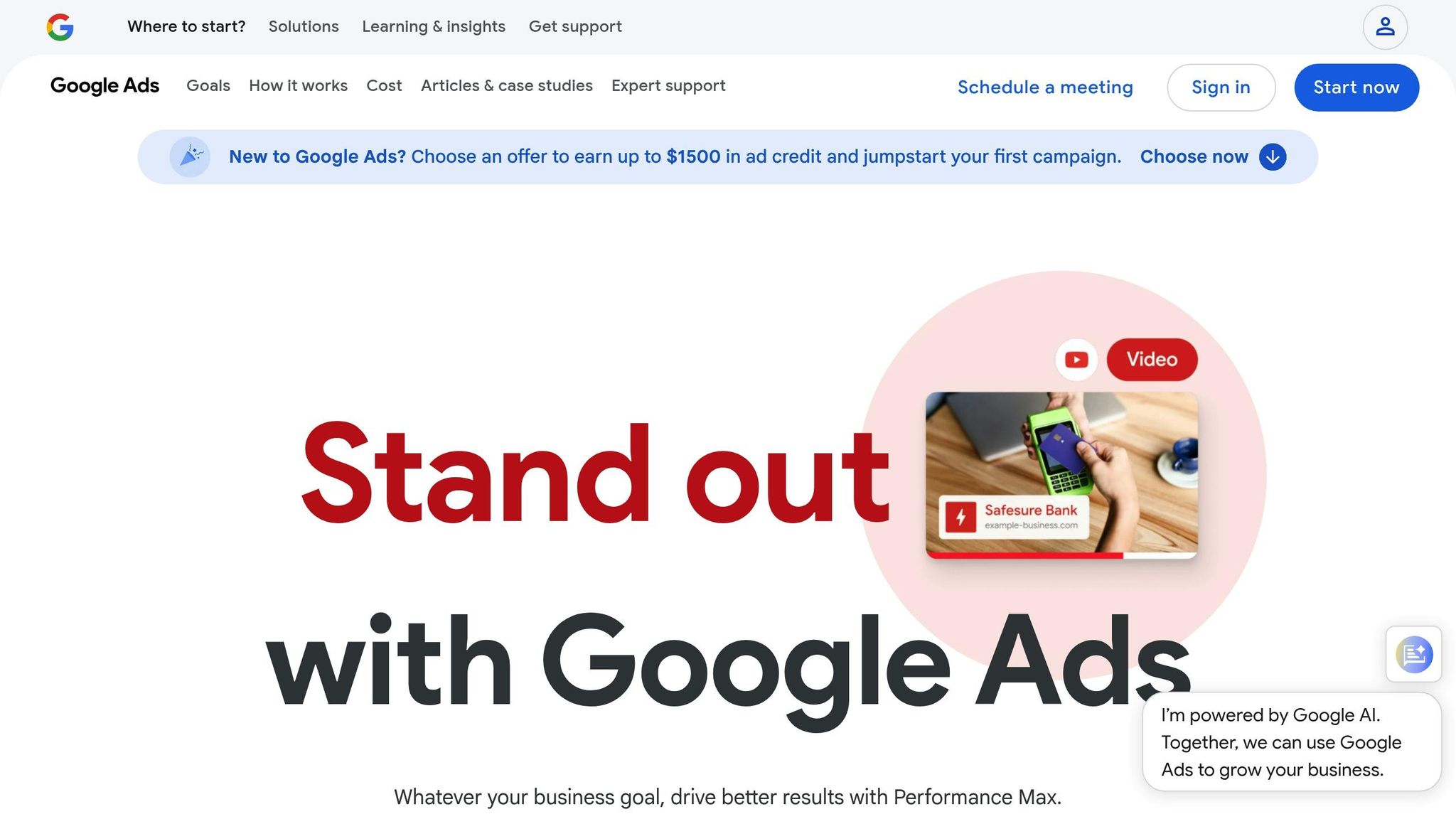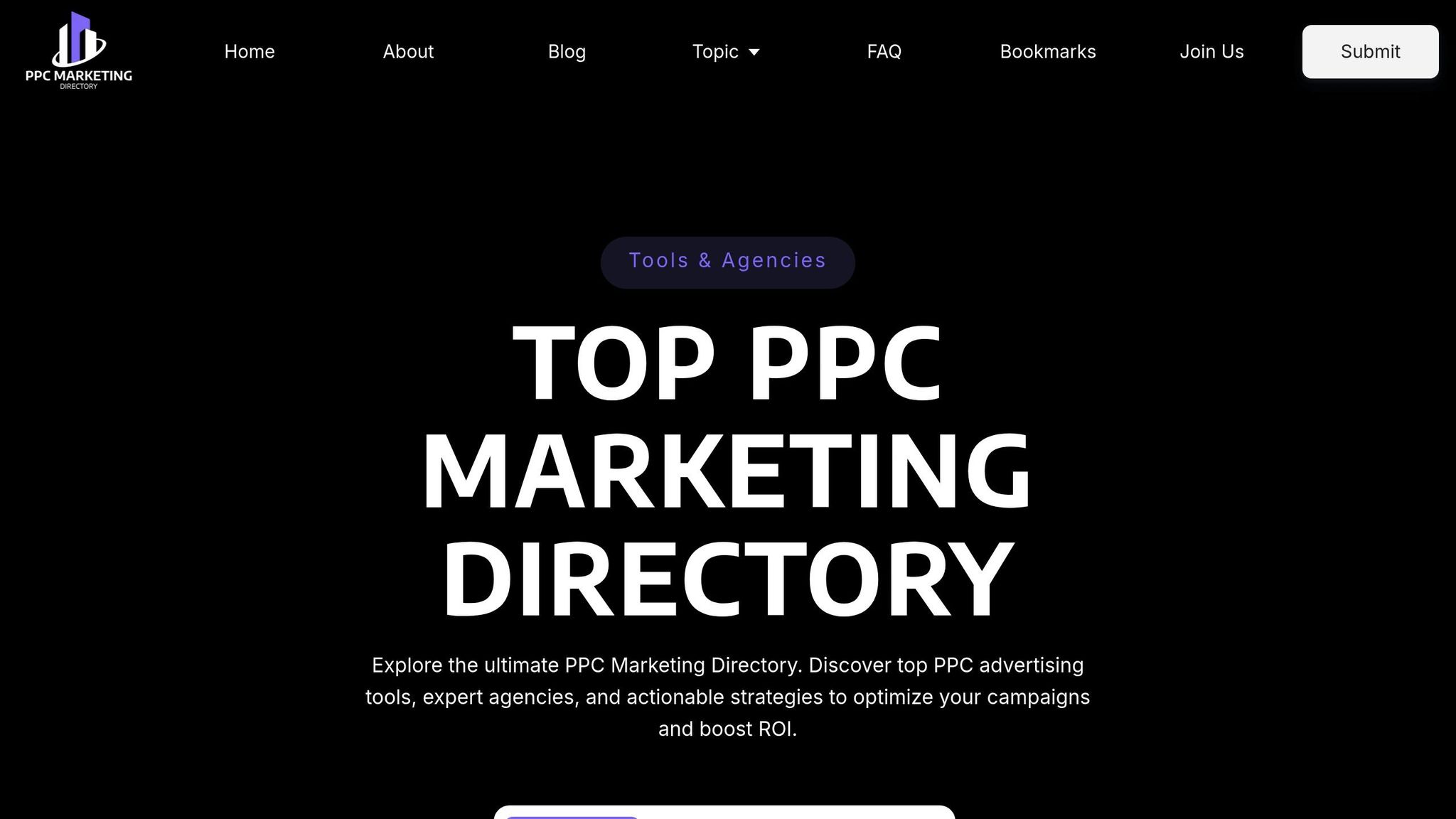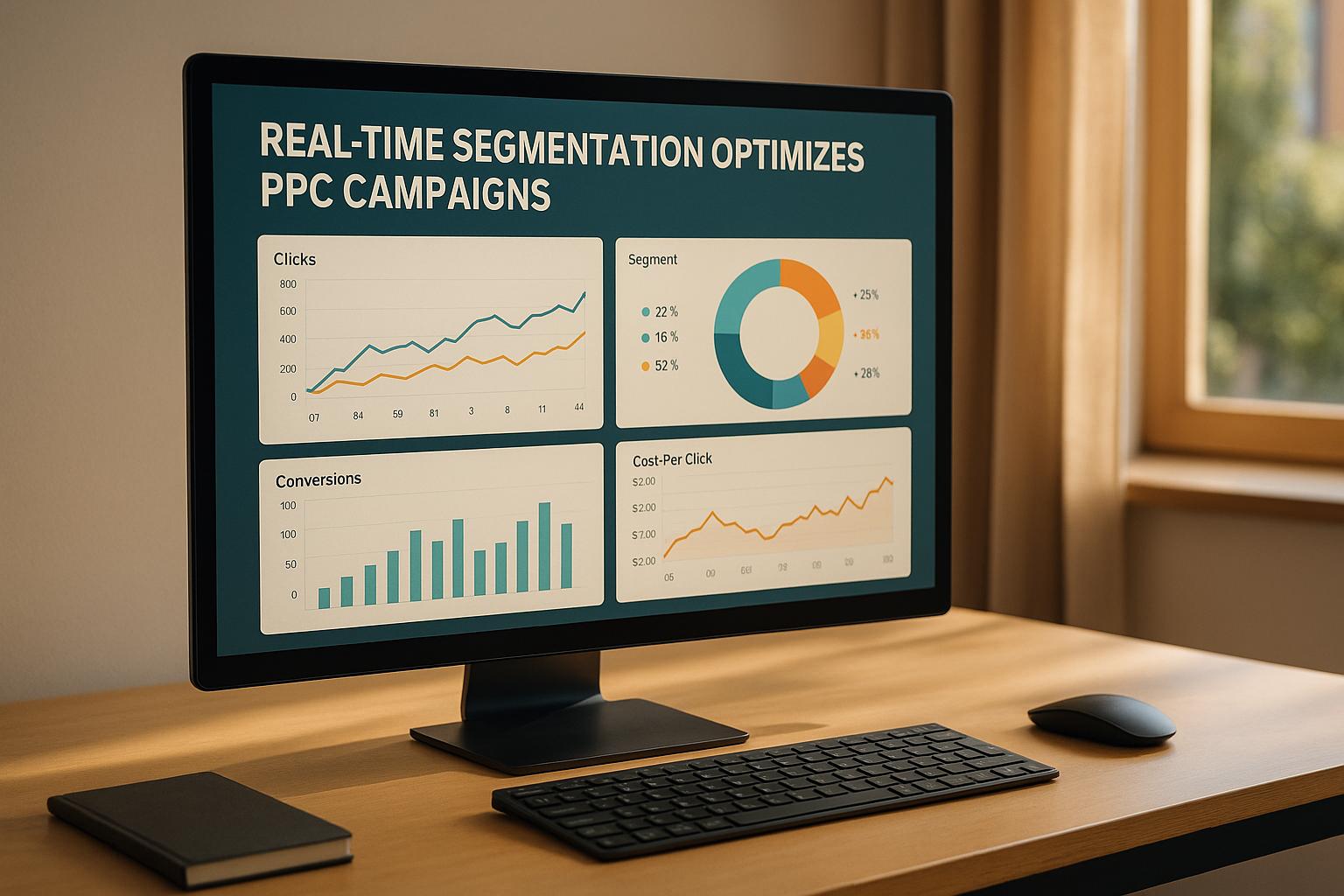When advertising on YouTube, your bidding strategy can directly impact how much you spend, how often your ads appear, and their overall performance. Here's a quick breakdown of the key strategies:
- Maximize Conversions: Focuses on getting the most conversions within your budget using automation.
- Target CPA (Cost-per-Acquisition): Lets you set a target cost per conversion, maintaining predictable costs.
- Cost-Per-View (CPV): Charges you only when viewers engage with your video, ideal for brand awareness.
- Target Impression Share: Prioritizes visibility by securing a specific share of ad placements.
- Enhanced CPC: Combines manual bidding with automated adjustments for better conversions.
- Maximize Conversion Value: Optimizes for the total value of conversions, ideal for campaigns with varying conversion values.
Each strategy aligns with specific goals, such as driving conversions, increasing traffic, or boosting brand visibility. To succeed, ensure proper conversion tracking, test strategies regularly, and adjust bids based on performance data. Tools like Google Ads and PPC management platforms can help you automate and refine your campaigns efficiently.
Every Google Ads Bid Strategy Explained (2025)

Main YouTube Ad Bidding Strategies
YouTube's bidding strategies are designed to align with specific campaign objectives, helping you achieve better results while staying within your budget. Here's a closer look at each strategy and how it can support your advertising goals.
Maximize Conversions
This automated bidding strategy uses machine learning to generate as many conversions as possible within your budget. It works best when there’s plenty of historical conversion data for the algorithm to learn from. Since it operates on automation, you can focus on other aspects of your campaign while the system optimizes for conversions. It’s an ideal choice for campaigns like e-commerce, lead generation, or app installs, where the primary goal is to achieve a high volume of targeted actions.
Target Cost-per-Acquisition (tCPA)
Target CPA lets you set a specific amount you’re willing to pay for each conversion. The system then adjusts bids automatically to maintain an average cost per conversion close to your target, all while aiming to maximize the total number of conversions. To make this strategy effective, it’s crucial to set a realistic target. This approach works well for campaigns with clear conversion values, such as subscription services, professional services, or retail sales with defined profit margins.
Cost-Per-View (CPV)
If your focus is on building awareness and engaging your audience, CPV bidding could be the way to go. With this strategy, you’re charged only when viewers engage meaningfully with your video, according to YouTube’s criteria. This gives you control over your cost per view, making it a solid choice for brand awareness and content promotion campaigns. However, since it doesn’t optimize for actions like website visits or purchases, it’s better suited for increasing visibility and audience interaction.
Target Impression Share
This strategy is all about visibility. Target Impression Share automatically adjusts bids to help you secure a specific share of eligible ad placements. It’s particularly useful for campaigns where maintaining a strong presence is crucial - such as protecting branded terms or running time-sensitive promotions. While this approach can help you secure premium placements, it may lead to higher costs since the focus is on visibility rather than direct performance metrics like conversions.
Enhanced Cost-per-Click (ECPC) and Maximize Conversion Value
ECPC combines manual bidding with automated adjustments based on the likelihood of a conversion. It’s a great option if you want to maintain control over your bids while introducing some automation.
On the other hand, Maximize Conversion Value takes automation further by focusing on the total value of conversions rather than their volume. This approach is especially effective for businesses where conversion values vary significantly, as it prioritizes more profitable opportunities - even if it means fewer overall conversions. It’s an excellent fit for campaigns that track revenue and aim to maximize profitability.
Here’s a quick summary of how these strategies compare:
| Strategy | Best For | Control Level | Data Requirements | Cost Predictability |
|---|---|---|---|---|
| Maximize Conversions | High conversion volume | Low | Sufficient historical data | Variable |
| Target CPA | Consistent cost per conversion | Medium | Historical CPA data | High |
| Cost-Per-View | Brand awareness and engagement | High | Minimal | High |
| Target Impression Share | Visibility in competitive markets | Medium | Minimal | Variable |
| Enhanced CPC | Testing automation | High | Some conversion data | Medium |
| Maximize Conversion Value | Varying conversion values | Low | Reliable revenue tracking | Variable |
How to Choose the Right Bidding Strategy
Now that you’re familiar with the available strategies, the next step is figuring out which one aligns best with your campaign goals. Picking the right bidding strategy is crucial - it should match your business objectives, available resources, and any constraints you’re working with. Here’s a practical way to approach this decision.
Matching Strategies to Campaign Goals
Your campaign goals should always dictate your bidding strategy. Let’s break it down:
- Brand awareness campaigns: CPV (Cost-Per-View) bidding is a great fit here. It helps control costs while maximizing reach, making it ideal for launching a new product or entering a new market where visibility takes priority over immediate conversions.
- Conversion-focused campaigns: If you’re aiming for high conversion volumes and have strong historical data, Maximize Conversions is a solid choice. For more predictable acquisition costs, go with Target CPA (Cost-Per-Acquisition).
- Revenue-focused campaigns: When your goal is to prioritize higher-value conversions over sheer volume, Maximize Conversion Value is the way to go. This strategy works especially well for e-commerce businesses with diverse product lines or service providers with varying pricing tiers.
- Competitive visibility campaigns: If staying visible is critical - like during peak seasons or when fending off competitors - Target Impression Share ensures your ads appear consistently, even if it means paying a premium for top placements.
Key Factors to Consider
When choosing a bidding strategy, keep these factors in mind:
- Budget flexibility: Automated strategies like Maximize Conversions or Maximize Conversion Value require more flexible budgets. If you’re working with tighter controls, consider CPV or Target CPA instead.
- Data availability: Automated strategies thrive on data. Ideally, you’ll need at least 30 conversions in the past 30 days for them to perform well. If you’re short on historical data, start with CPV or Enhanced CPC while building your conversion history.
- Market competition: In highly competitive industries, automated strategies often outperform manual ones because they adjust bids in real time. On the other hand, in less competitive niches, manual bidding with Enhanced CPC can give you good results while still offering control.
- Campaign timeline: Short-term campaigns benefit from strategies that deliver quick outcomes, like Target Impression Share for instant visibility or CPV for rapid engagement. For long-term campaigns, automated strategies like Maximize Conversions or Target CPA can take advantage of their learning period to optimize over time.
Once you’ve selected your strategy, you can fine-tune it further with targeted bid adjustments.
Using Bid Adjustments to Improve Performance
Bid adjustments let you refine your strategy based on how different segments perform. Here’s how you can use them effectively:
- Device adjustments: Mobile users often behave differently than desktop users. If mobile conversion rates are higher, consider increasing mobile bids by 20–30%.
- Location-based adjustments: If certain regions, like specific states or cities, consistently deliver better results, raise bids by 15–25% in those areas to improve efficiency.
- Time-of-day adjustments: Boost bids during peak hours when your audience is most active. For instance, consumer products might see higher engagement from 7–9 PM, while B2B campaigns may perform better in the mid-morning, around 9–11 AM. Adjust bids by 10–20% during these times and lower them during off-peak hours.
- Audience adjustments: Tailor bids for high-value segments like past website visitors or loyal customers. You can increase bids by as much as 300% for these groups or reduce them for broader, less-qualified audiences by up to 50%.
Start with small bid adjustments - around 10–20% - and monitor performance over two weeks before making significant changes. This gradual approach helps you avoid drastic budget shifts while identifying the most effective optimizations for your campaign goals.
sbb-itb-89b8f36
YouTube Ad Bidding Best Practices
Nailing your YouTube ad bidding strategy isn't just about picking the right approach - it’s about following proven methods to optimize your performance and minimize risks. These actionable tips will help you get the most out of your bidding efforts, no matter which strategy you use.
Start with Lower Bids and Scale Up
Starting conservatively with your bids is a smart way to protect your budget while gathering critical performance data. This approach allows you to test the waters and make adjustments based on real results.
For example, if you estimate a competitive cost-per-view (CPV) at $0.15, begin with bids around $0.10 to $0.12 - roughly 20-30% lower. Monitor key metrics like impression share, average position, and cost-per-result during the first week. If your impression share drops below 50%, consider increasing your bids by 15-20% every few days.
This cautious approach is especially important for automated strategies like Maximize Conversions or Target CPA. These algorithms need time to "learn" and optimize. Starting with aggressive bids can quickly drain your budget before the system has enough data to make smarter decisions.
Once you identify what works, scale up strategically. If certain demographics, locations, or time periods perform well, focus your budget on those areas instead of applying blanket increases. This targeted scaling ensures you’re maximizing returns where they matter most while keeping costs under control elsewhere.
Set Up Conversion Tracking Properly
Accurate conversion tracking is the backbone of effective bidding. Without reliable data, even the most advanced strategies can fall flat. YouTube’s automated bidding tools rely heavily on conversion signals to make real-time adjustments, so getting this step right is non-negotiable.
Before launching your campaign, set up conversion tracking using tools like Google Tag Manager and Google Ads. Define the actions that matter most to your business - whether it’s purchases, signups, calls, or downloads - and assign clear values to each. This helps the algorithms prioritize high-value outcomes.
For better accuracy, enable enhanced conversions. This feature is especially useful if your customers often convert on different devices or after a long consideration period. It helps connect ad clicks to actual conversions, providing a fuller picture of your campaign’s performance.
To ensure everything runs smoothly, test your conversion setup before going live. Verify that conversion values are accurate and that the timing between clicks and recorded conversions aligns with your business model.
If you handle offline conversions, like phone calls or in-person sales, upload this data to Google Ads. Including these offline actions gives automated bidding strategies a clearer understanding of traffic value, leading to smarter adjustments.
Make it a habit to review your conversion data weekly. Look for unusual trends - like sudden dips in conversion rates or mismatched traffic patterns - and address any issues immediately. Even brief periods of inaccurate data can throw off your bidding performance.
With reliable tracking in place, you’ll be in a strong position to refine your bids and adapt to changing market conditions.
Test and Adjust Regularly
Once your bids and tracking are dialed in, regular testing becomes essential to maintaining and improving results. YouTube’s ad environment is always evolving, with new features, shifting audience behaviors, and changing competition. Staying proactive with testing helps you stay ahead.
Run A/B tests on bidding strategies every 4-6 weeks. For instance, split similar campaigns and compare Maximize Conversions against Target CPA for the same audience and creative. Let these tests run for at least two weeks to account for daily performance fluctuations.
Dive deep into your performance data. While overall campaign metrics are important, don’t overlook details like device performance, location, time of day, or audience segments. You might find that a Target CPA strategy works well for mobile users but struggles on desktop, prompting adjustments.
Keep a record of your test results. Document what you tested, when, and the outcomes. This historical data will be invaluable for making smarter decisions in the future.
Adjust your strategies based on seasonal trends and business cycles. What works during back-to-school season might not be as effective during the holidays. Review your bidding performance quarterly and be ready to pivot as market conditions or priorities shift.
Also, stay informed about YouTube’s latest bidding features and beta programs. Google frequently rolls out new tools and updates, and being among the first to use them can give you an edge while others stick to older methods.
Balancing automation with hands-on strategy is key to successful YouTube ad bidding. While automated tools are powerful, they work best when paired with quality data, clear goals, and ongoing adjustments based on real-world performance insights.
PPC Tools and Resources for Bidding Management
Running effective YouTube ad campaigns isn’t just about having a solid strategy - it’s also about using the right tools and resources to manage your bids efficiently. Whether you’re trying to avoid overspending or aiming for better results, PPC tools can make a big difference at every stage of your bidding process.
How PPC Tools Enhance Campaign Management
Bid management tools take the hassle out of manual adjustments by automating bid changes across campaigns. These tools rely on algorithms to fine-tune bids based on factors like performance metrics, time of day, device usage, and audience behavior. This saves time and ensures that your bids align with real-time data.
Performance tracking software goes beyond basic analytics, offering insights that connect your bidding strategies to broader campaign results. These platforms help you figure out which bidding tactics resonate with specific audience segments and how your video ads contribute to overarching business goals.
Keyword research platforms are invaluable for refining YouTube ad targeting. While YouTube ads differ from search ads, understanding search trends can help you craft better targeting strategies and more engaging ad content.
A/B testing tools let you experiment with different bidding strategies and creative elements for your video ads. By quickly identifying what works best, these tools help you allocate your budget to the most effective combinations.
Campaign automation software handles repetitive tasks like pausing low-performing ads, adjusting bids based on conversions, and scaling successful campaigns. This automation frees you up to focus on the creative and strategic aspects of your campaigns, knowing that the operational side is running smoothly.
Top PPC Marketing Directory Overview

For advertisers focused on YouTube, finding the right tools for bid management is crucial. That’s where the Top PPC Marketing Directory comes in - a resource designed to streamline your search for the best PPC tools and services.
This directory offers a carefully curated list of PPC advertising solutions, including tools for bid optimization, keyword research, A/B testing, retargeting, and performance tracking. Instead of spending hours researching options, you can browse verified resources tailored to your needs. The directory also provides detailed comparisons of features, pricing, and use cases, making it easier to choose the right tools for your campaigns.
For YouTube-specific needs, the directory highlights resources that focus on video ad optimization, audience targeting, and managing campaigns across multiple platforms. Additionally, it includes listings for expert agencies specializing in YouTube advertising and bidding strategies, complete with details about their expertise and contact information. This makes it simple to find the right partners for your advertising goals.
Using the Directory to Improve Your Bidding Strategy
The bid management section of the directory is especially useful for navigating YouTube’s automated bidding features. These tools simplify complex strategies, allowing advertisers to implement advanced techniques without needing extensive technical knowledge or constant monitoring.
A/B testing tools listed in the directory are perfect for comparing multiple bidding approaches. Many of these integrate with Google Ads, making it easy to test and refine your strategies.
Performance tracking solutions in the directory offer valuable attribution modeling, which is particularly helpful for YouTube campaigns. Since video ads often influence potential customers over time, these tools help you measure the true impact of your bidding efforts and optimize your investments.
Additionally, the directory includes all-in-one platforms that combine bid optimization, performance tracking, creative testing, and audience analysis into a single dashboard. This unified approach is especially helpful for advertisers running multiple YouTube campaigns with different goals.
Conclusion
To get the most out of YouTube ads, mastering bidding strategies is a must. The key is matching the right strategy to your campaign goals. Whether you're aiming to boost conversions with Maximize Conversions, keep costs in check using Target CPA, or build brand awareness through CPV bidding, aligning your approach with your objectives sets the stage for success.
It all starts with proper conversion tracking and using Smart Bidding, which taps into historical data for real-time adjustments. But the real game-changer? Consistent optimization. Regularly monitoring metrics like click-through rates, cost per click, and conversion rates - and making data-driven tweaks - keeps your campaigns sharp and effective.
Platforms like the Top PPC Marketing Directory also offer resources to simplify bid management. The right tools can help you implement advanced strategies without needing to micromanage every detail.
Success on YouTube isn't just about choosing the right bid strategy - it's about combining it with engaging video content, precise targeting, and ongoing optimization. This mix ensures you maximize ROI and stay ahead in a fast-changing digital space.
As YouTube ads continue to evolve with new features and opportunities, staying informed and adapting your strategies will be essential to keeping your campaigns competitive and delivering strong results.
FAQs
What’s the best YouTube ad bidding strategy for my campaign goals?
The right YouTube ad bidding strategy depends entirely on your campaign goals. If you're aiming to boost conversions, options like Maximize Conversions or Target CPA (Cost Per Acquisition) are excellent. These approaches rely on machine learning to focus on specific actions, such as sign-ups or purchases.
If your focus is on building brand awareness or increasing video views, you might want to try Target CPM (Cost Per Thousand Impressions) or Target CPV (Cost Per View). These strategies are designed to prioritize impressions or encourage viewers to engage with your content.
To make the most of your budget and optimize performance, always choose a bidding strategy that aligns closely with your campaign's primary objective.
What should I consider when setting a target CPA for my YouTube ad campaigns?
When determining a target CPA (Cost Per Action) for your YouTube ad campaigns, it's important to consider a few critical factors that can impact your success:
- Industry benchmarks: CPAs can vary widely across industries. Take the time to research what’s typical for your specific niche to set realistic expectations.
- Seasonality: Performance often shifts during holidays, seasonal trends, or major events. Keep these fluctuations in mind when setting your target.
- Competition: If your market is highly competitive, you might see higher CPAs. Be prepared to adjust your target based on the level of competition.
- Budget and goals: Your target CPA should align with your overall budget and the return on investment (ROI) you’re aiming for.
- Historical data: Past campaign performance is a goldmine of insights. Use it to establish a practical starting point and refine your strategy over time.
Start with a realistic target and allow your campaign some time to optimize. As you collect more performance data, you can tweak your CPA to better align with your goals and maximize results.
How can I use bid adjustments to boost the performance of my YouTube ad campaigns?
To get the most out of your YouTube ad campaigns, pay close attention to bid adjustments. By pinpointing segments that perform well - like specific locations, device types, or times of day - you can boost bids to enhance visibility and drive more conversions. For instance, if your ads tend to do better on mobile devices or during certain hours, it’s worth allocating higher bids to those areas.
Make it a habit to review your campaign data frequently. This helps you fine-tune your adjustments and focus on reaching the most valuable audiences. You might also explore automated Smart Bidding strategies, which use machine learning to adjust bids in real time. These tools not only help you stay competitive but also save you time by reducing the need for constant manual tweaks - all while aiming to improve your return on investment.


